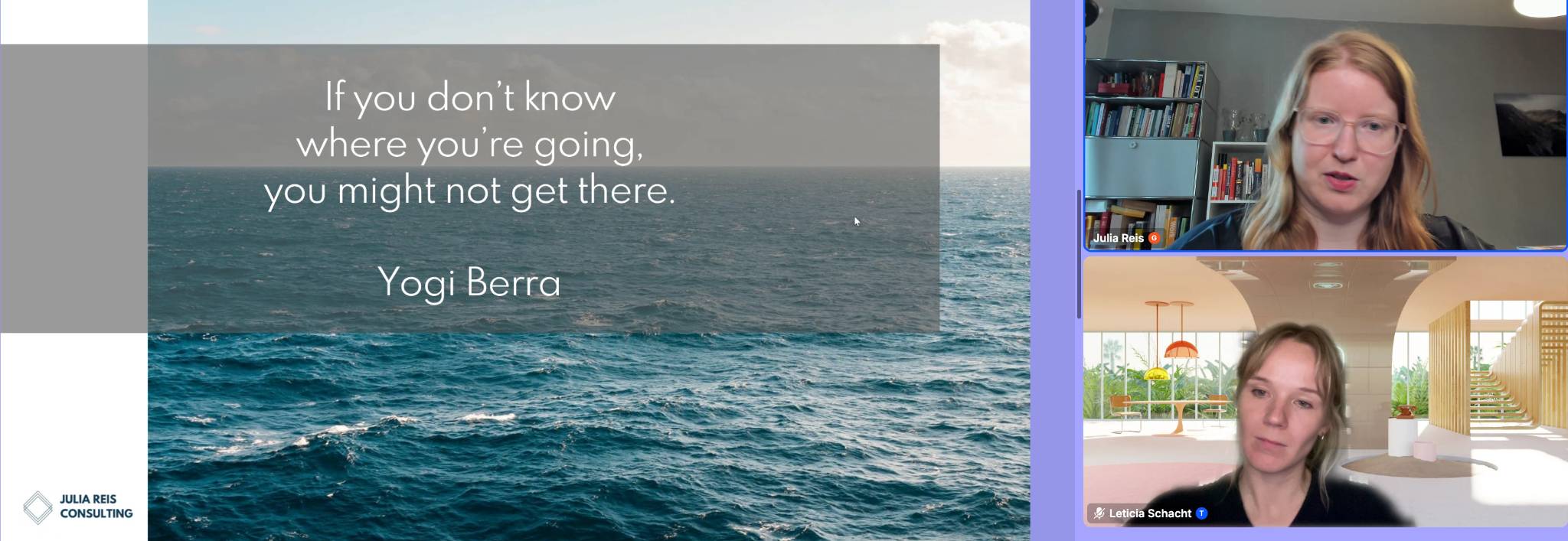Warum OKRs scheitern - und was du dagegen tun kannst
OKRs sind eine der beliebtesten und effektivsten Methoden für die Festlegung ehrgeiziger, abgestimmter Ziele in modernen Organisationen. Dennoch geben viele Teams, die sie ausprobieren, die Methode nach nur wenigen Zyklen wieder auf. Und warum?
In einer Leapsome Learning Session teilte Julia ihre Erkenntnisse darüber, warum OKRs scheitern - und was du tun kannst, damit sie für dein Team funktionieren.

Was sind OKRs - und warum funktionieren sie?
OKRs (Objectives and Key Results) sollen Teams dabei helfen, sich auf das Wesentliche zu konzentrieren, sich an gemeinsamen Prioritäten auszurichten und Fortschritte transparent zu verfolgen. Wenn sie gut gemacht sind, fördern sie Ehrgeiz, Klarheit und Verantwortlichkeit. Aber allzu oft sind die richtigen Bedingungen nicht gegeben.
Drei Gründe für das Scheitern von OKRs
1️⃣ Fehlende (kulturelle) Grundlagen
Selbst gut formulierte OKRs werden scheitern, wenn die kulturellen und methodischen Grundlagen nicht vorhanden sind. Ohne die Zustimmung der Führungskräfte, psychologische Sicherheit und die Bereitschaft, zu reflektieren und aus verfehlten Zielen zu lernen, werden OKRs oft nur zu einer weiteren Check-the-Box-Übung. Die Definition sinnvoller OKRs ist nicht trivial, daher müssen deine Teams die Grundlagen dieser Methode verstehen. Die Angst vor dem Scheitern und mangelnde Transparenz können den gesamten Prozess weiter untergraben.
✅ Was du tun kannst:
- Sicherstellen, dass die Führungsebene die OKR-Mentalität versteht und unterstützt
- Durchführen von Trainings für Teams, die neu mit OKRs arbeiten, und Sicherstellung, dass das "Warum der OKRs" allen klar ist
- Ehrgeizige Ziele feiern, auch wenn sie nicht ganz erreicht werden
- Förderung von Offenheit und Reflexion darüber, was funktioniert hat und was nicht
2️⃣ Das falsche Mindset: OKRs mit KPIs oder Performance Management verwechseln
Einer der häufigsten Fehler besteht darin, OKRs als Performance Management zu betrachten. Wenn individuelle Boni, Gehälter oder Leistungsbeurteilungen direkt an die OKRs gekoppelt sind, neigen die Mitarbeitenden dazu, auf Nummer sicher zu gehen, indem sie sich niedrige, erreichbare Ziele setzen. OKRs sind als gemeinsame Ziele für das Team gedacht und nicht als Instrument zur Bewertung der individuellen Leistung.
KPIs hingegen eignen sich am besten zur Messung der konstanten betrieblichen Leistung und nicht zur Anregung von Streckungs- oder Lernzielen.
✅ Was du tun kannst:
- Fördere Ehrgeiz, indem du OKRs von individuellen Beurteilungen entkoppelst - verbinde OKRs nicht mit Entscheidungen über Boni oder Beförderungen
- Verwende KPIs, um den allgemeinen Zustand und die Leistung deines Unternehmens oder Teams zu verfolgen, und OKRs, um neue Bereiche zu erschließen
- Verstehe OKRs als kollektiven Zielsetzungsprozess und nicht als Aufgabenliste
3️⃣ Mangel an Struktur und Verantwortlichkeit
OKRs erfordern mehr als nur das Setzen von Zielen zu Beginn des Quartals und das Vergessen derselben. Ohne klare Zuständigkeiten, regelmäßige Überprüfungen und eine transparente Art der Fortschrittsverfolgung können OKRs leicht aus dem Blickfeld geraten.
✅ Was du tun kannst:
- Weise klare Rollen zu (z. B. OKR-Master, KR-Owner)
- Baue regelmäßige Rituale wie OKR-Planung, wöchentliche Check-Ins, Reviews und Retrospektiven ein
- Verwende ein einfaches, sichtbares Tool, um Fortschritte zu verfolgen (wie Leapsome 😉 oder beginne mit einer einfachen Tabelle)
- Halte den Prozess leicht, aber konsistent
.png)
Bist du bereit, OKRs für dein Unternehmen zu nutzen?
Wir helfen Organisationen, OKRs einzuführen, die Bestand haben - und die eure Strategie und Kultur unterstützen. Ganz gleich, ob ihr gerade erst anfangt oder euren bestehenden Prozess verbessern wollt, wir bieten:
- OKR-Kickoff-Package: Bringe dein Team auf Kurs und startet mit Zuversicht
- OKR-Master-Schulung: Statte eure internen OKR-Champions mit dem nötigen Wissen aus
- OKR-Sparring-Sitzungen: Unterstützung und Coaching auf Abruf während eurer OKR-Zyklen
Kontaktiere uns, um mehr zu erfahren.

